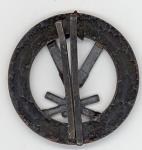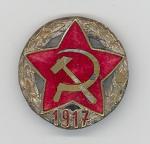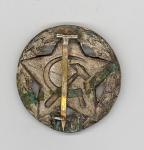
JBFloyd
Moderator-
Posts
1,242 -
Joined
-
Last visited
-
Days Won
2
Content Type
Profiles
Forums
Blogs
Gallery
Events
Store
Everything posted by JBFloyd
-
When we learn to distinguish between how things should be and how things actually are, we take a big step in understanding what we collect. This is one of those cases where the regulations said one thing and the veteran did as he pleased -- he earned them, and he'll wear them as he saw fit. Thank goodness many vets thought this way or there would be far too many EK/Hindenburg Cross pairs out there.
-
Medal ribbons fade to white
JBFloyd replied to a topic in Preservation & Restoration of Military Artifacts
I doubt the ribbon was artificially aged; it just touched a cleaning solution. I haven't looked at values of the various bars in a long time, so I'm way out of date on prices of Iraqi medals. -
Medal ribbons fade to white
JBFloyd replied to a topic in Preservation & Restoration of Military Artifacts
Since the light spots are not uniform or widespread, I doubt that they are fading. Somewhere along the way, the medal was probably cleaned with a chemical cleaning solution that caused bleaching where it hit the ribbon. -
Do American Presidents accept foreign Orders
JBFloyd replied to Herr General's topic in United States of America
Yes, they do. Usually with little fanfare and press coverage (in the US, at least). The awards normally wind up in the presidential library. The awards are often delayed until after the president leaves office. Ronald Reagan received a civil Order of the Bath after he left office. That got press coverage, with the explanation that he could not call himseld "Sir Ronald", etc. Protocol says you accept such awards when offered. Law says you can't accept them. The compromise is quietly accepting them. -
Simon Bolivar Breast Star ?
JBFloyd replied to Linasl's topic in Rest of the World: Militaria & History
This is the breast star of the third class (commander's grade) of the Venezuelan Order of the Liberator, also referred to as "The Bust of Bolivar". Mayer made these in the 1960s period and perhaps later. Mayer was fairly aggressive in marketing its insignia-making to Latin America, taking advantage of the situation in Cuba, where Villardebo y Riera were limited in their outside contacts. Some of the early 20th Century stars of the order were made in Venezuela, with quality matching anything produced in Europe. I suspect that Mayer got the contract based on cost. The Order of the Liberator is a 5-class order, founded in 1825 and revised over the years. Its current form really dates from revisions in 1912 and it's still active today as a military and civil order for merit. Some sources say the proper name is the "Order of the Bust of Bolivar", but the cases for the order insignia say "Orden del Libertador" (Order of the Liberator). -
Q2: Did the Turkish Korean War Veterans change the blue and white UN ribbons into red ribbons (as sold by some companies as vintage ribbons) because it resembles the Greek flag? A2: No, they did not and it is absurd to claim such an idea. Based on about 50 years of observation, I can relate a little non-scientific evidence on this matter. However absurd the idea might be, I can assure you that fully half of the Turkish UN Korea Medals I have seen that showed signs of being worn were on red ribbons. Every red ribbon had a buttonhole cut into it and clear signs that it had been worn that way. I'm sure Turkish military regulations and customs have prohibited such wear, but it did happen.
-
DFC award list / database?
JBFloyd replied to Adam J's topic in Great Britain: Research, Documentation & History
There is a published source for DFCs: Carter, Nick J. and Carol Carter. The Distinguished Flying Cross and How It Was Won, 1918-1995. London, 1998. It has the Gazette dates and citations. -
Bulgaria Bulgarian order - which one?
JBFloyd replied to Valter's topic in Central & Eastern European States
Looks original. You'll see these in the market at US$65-75. -
Bulgaria Bulgarian order - which one?
JBFloyd replied to Valter's topic in Central & Eastern European States
This is the Silver Cross of the Order of St. Alexander. This type, with the royal crown suspension, was created during WWII by King Boris III. The date on the reverse, 19 February 1878, refers to the Treaty of San Stefano, which established Bulgaria as an autonomous nation. -
Interesting US Medal - Military, Civil, or Fantasy?
JBFloyd replied to Linasl's topic in United States of America
The text of the draft for the OMSA Journal article (with permission of the author): Everybody “knows” about the Grand Army of the Republic funeral badge. That’s the white enameled cross with the gold eagle in the center and the plain black ribbon, isn’t it? Well, there is no Grand Army of the Republic funeral badge and what everybody “knows” is incorrect. The “GAR funeral badge” is probably the most commonly misidentified American medal and that identification stems from incomplete research. In 1990, Rev. Brad Long privately published a monograph, “Collecting Grand Army of the Republic Memorabilia”, in an effort to fill a gap in the literature of Civil War collecting. Long illustrated a variety of GAR badges and insignia, including what he described as the “Death Medal”. He goes on to say “The medal is perhaps mistaken for a Masonic Order or VFW device. The medal was usually given to the widow or surviving family upon the death of a GAR member.” He continues by noting “This medal was also used extensively by non-GAR fraternal organizations.” Unfortunately, this is where incomplete research negates the value of the monograph. Long’s second edition, published in 1992, made an attempt to answer the critics of his work, but he simply then referred to the badge as “unofficial”. He did note that the “origin of the badge can be traced to other fraternal organizations, to include, but not limited to, the Masonic orders.” The obfuscation of the real origin of the badge not only continued, but was used by another author in a book for collectors. Turner E. Kirkland published “Civil War Veterans’ Organizations, Reunions and Badges” in 1991. In it, he refers to the medals being “given to a soldier’s family upon his demise...Some feel areas with heavy Masonic population influenced this medal.” Unfortunately, Lee Bishop and J. Robert Elliott provided another source for the mis-identification in their “American Society Medals”, where it is listed as the “GAR Death Badge”. So, what is the “GAR funeral badge” really? It is the Malta Jewel of the Knights Templar, a Masonic organization. In the Knights Templar hierarchy, the Malta Jewel represents the second level order (the first-level order is the Order of the Temple and the third-level, or highest, order is the Illustrious Order of the Red Cross). The Malta Jewel has been in existence at least since the 1880s and has been manufactured in a variety of styles. Some have plain gold centers, others have the centers enameled in various colors, some have enameled eagles in the center, some will have top bars, etc. Why the confusion over this simple badge? The 1880s saw a tremendous expansion of fraternal organizations and it was common that a man would join several societies. He might join the GAR based on his military service, the Knights Templar based on his church connections and another society offering mutual insurance benefits. Most of these organizations had medals and badges for their members to wear. When a man had a formal portrait taken, it was not uncommon to see him wearing all of his society regalia. It is common to see men of the period wearing both GAR and Masonic regalia, which can lead to false assumptions about the origins and use of many badges. These portraits, however, did not lead modern authors to an obvious question – “Why are so many living individuals photographed wearing a “GAR funeral badge”? The answer is that they were not. They were wearing the Malta Jewel, symbolic of their position in the Knights Templar. -
Unknown Eastern European badge
JBFloyd replied to JBFloyd's topic in Central & Eastern European States
Thanks for the lead. -
This badge has a brass/bronze wreath with a red star at the top, surrounding a range-finder with crossed cannons at its base. With opposing slide-on pins (similar to Hungarian Combat Leader's Badge). Unmarked, 42mm. Any identification help would be appreciated.
-
This is a silvered brass/bronze badge, 40mm in diameter, with a vertical pin on the reverse (which looks like German Wound Badge pins of the period). Any help with an identification would be greatly appreciated.
-
Silver Star question, actually, 2......
JBFloyd replied to Chris Boonzaier's topic in United States of America
1st Division General Order #1 of 1920 listed about 14,000 citations saying "For gallantry in action and especially meritorious services". The list was, in essence, the casualty roll (KIA and WIA) of the 1st Division. 2nd Division General Order 64 of 25 June 1919 listed about 2400 men "for gallantry in action against the enemy in the ___ Sector." This too azppears to be at least a partial casualty roll. In both cases, "gallantry" was defined very loosely -
Silver Star question, actually, 2......
JBFloyd replied to Chris Boonzaier's topic in United States of America
Certainly all those cited in division General Orders did. I've never run into one of those that was disapproved. -
Silver Star question, actually, 2......
JBFloyd replied to Chris Boonzaier's topic in United States of America
Those 1st Division men who were wounded were cited for "gallantry" in division orders. In 1932, when the Silver Star Medal and Purple Heart came along, the object was to replace the "Silver citation star". Anyone with a "Silver Citation star" would get a Silver Star Medal. However, there was a review process and some citations were deemed "not meriting decoration". I believe these were generally citations made below the brigade level. There must have also been some kind of appeal process, because I've seen the "not meriting decoration" stamp lined out and a Silver Star Medal awarded. -
There were large numbers of Japanese officers who were members of the MIlitary Order of the Dragon from their service in China for the Boxer Rebellion. However, I've never a Military Order of the Dragon to a Japanese office in the market. Where did they all go?
-
Interesting. I've never seen a bow-mounted Boxer Campaign Medal before, but I do notice that it is constructed differently from the other bow-mounted pieces in the case. I'd want some additional information on the way this one is put together.
-
Purple Heart - Col. Douglas C. McNair, son of LTG Leslie McNair
JBFloyd replied to Hugh's topic in United States of America
Great! It's always good to get a refund on tuition at the College of Hard Knocks. -
Purple Heart - Col. Douglas C. McNair, son of LTG Leslie McNair
JBFloyd replied to Hugh's topic in United States of America
The examples Darrell illustrates are the accepted naming styles for Army Purple Hearts, as done at the Philadelphia QM Depot. They do NOT include rank, dates, branch, or KIA/WIA/POW. Get to know these styles and you'll quickly learn to spot the non-standard namings. -
Purple Heart - Col. Douglas C. McNair, son of LTG Leslie McNair
JBFloyd replied to Hugh's topic in United States of America
Hugh, Check out this thread on the US Militaria Forum: www.usmilitariaforum.com/forums/index.php?showtopic=64330&hl= It talks about some fake engraving going on the central Florida where all sorts of unusual things are popping up at flea markets and military shops. The style of naming is fairly consistent, although the fakers have moved to earlier style brooches (slot). Unfortunately, I think this one is another of that batch. -
It's a design used by most of the French Ministries for their Medals of Honor. Unfortunately, the issung agency is noted on the reverse.
-
Thanks to all for the help on the identifications.




